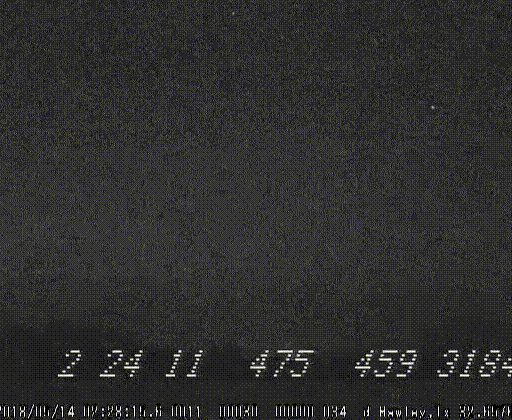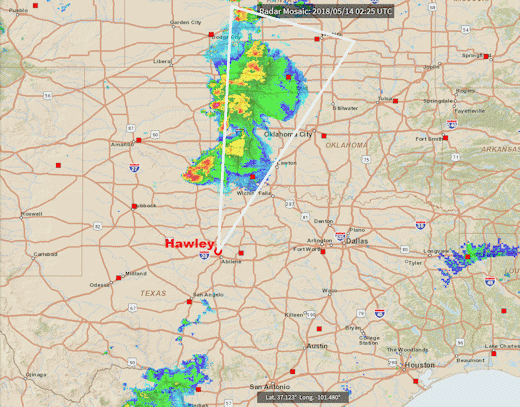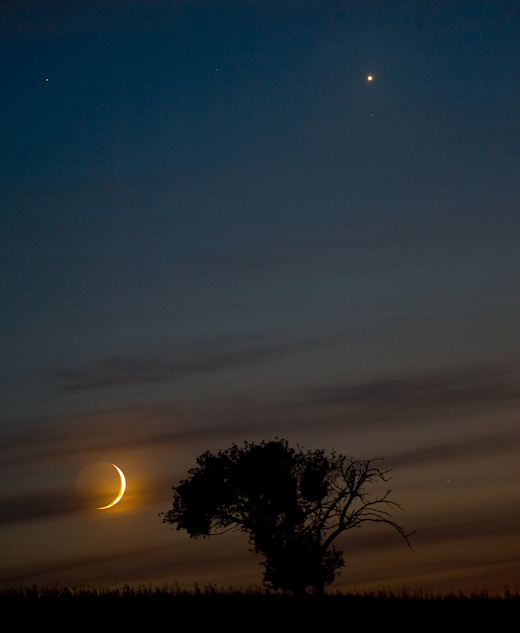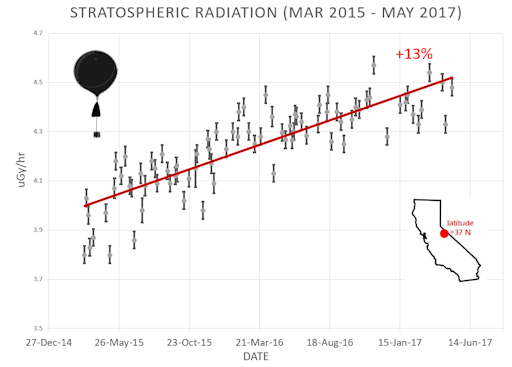All-inclusive Northern Lights trips in Tromsø, Norway. Small groups, big experiences! Highly qualified guides ensure unique and unforgettable adventures with a personal touch. Visit Explore the Arctic | | |
REDUCED CHANCE OF GEOMAGNETIC STORMS: NOAA forecasters have reduced the odds of a geomagnetic storm today from 60% to 40%. A stream of solar wind reached Earth on May 17th and it is now buffeting our planet's magnetic field. So far, however, the stream is slower and less potent than originally expected. Free: Aurora Alerts.
TEXAS-SIZED SPRITES: Technically, summer hasn't started yet in the USA, but summer thunderstorms are already rumbling across the Great Plains, bringing with them strange forms of upper atmospheric lightning. "Sprite season is definitely picking up here in Texas," reports Kevin Palivec, who operates an array of night-sky cameras in the town of Hawley. This week he has photographed a flurry of lightning-like forms including this Gigantic Jet shooting up from a thunderstorm in Oklahoma:

Click to view the full-length video
"The line of storms in Oklahoma was perfectly positioned for me to record these jets leaping over the cloudtops about 300 miles away," says Palivec. "I used a Watec 902h Ultimate black and white camera in a pan tilt weatherproof housing on a 20 foot tower."
Gigantic jets are like sprites on steroids. They are rare and far more powerful than their smaller red cousins. "I've been monitoring the skies here in Texas for 6 years. To date, I've only caught 5 gigantic jets--two of which have been studied in research papers. It is always exciting to see them."

On night later, on May 15th, "another line of storms moved through producing sprites to my north and south!" says Palivec.
Some researchers think that sprites and gigantic jets may be linked to cosmic rays: Subatomic particles from deep space strike the top of Earth's atmosphere, producing secondary electrons that trigger the upward bolts. If this is true, then sprites could multiply in the years ahead as cosmic rays intensify due to the decline of the solar cycle.
Although sprites have been seen for at least a century, most scientists did not believe they existed until after 1989 when sprites were photographed by cameras onboard the space shuttle. Now "sprite chasers" like Palivec routinely photograph sprites from their own homes. Give it a try!
Realtime Sprite Photo Gallery
A CRYSTAL BALL IN THE STRATOSPHERE: Father's Day is less than a month away. To get ready, the students of Earth to Sky Calculus launched a crystal ball to the stratosphere. Watch the video as the crystal orb travels onboard a giant helium balloon 93,000 feet above Earth's surface, stretching, focusing, and inverting the incredible landscape of the Sierra Nevada mountains behind it:
The students are selling these crystal balls as a fundraiser, and you can have one for $229. The 800 gram sphere contains an embedded model of the Solar System, including the sun, eight planets and their moons. It makes an incredible gift for anyone interested in space. Dad-satisfaction guaranteed.
Each crystal ball comes with a unique gift card showing the item at the edge of space and telling the story of its flight. All proceeds support Earth to Sky Calculus and hands-on STEM research.
Far Out Gifts: Earth to Sky Store
All proceeds support hands-on STEM education
SUPER CRESCENT MOON AND VENUS: Last night's crescent Moon was a "supermoon." It occurred at perigee--the side of the Moon's elliptical orbit closest to Earth. This made the crescent 5% wider and almost 11% brighter than average crescent Moons of the same phase. Marek Nikodem sends this picture from Szubin, Poland:

"The twilight sky was beautiful as the perigee crescent Moon appeared alongside Venus," says Nikodem.
Nikodem's photo also captured the Da Vinci Glow--a.k.a. "Earthshine." Sunlight reflected from Earth onto the dark lunar surface formed an image of the full Moon inside the arms of the crescent. In the northern hemisphere, Earthshine is extra visible in spring because springtime crescent Moons are high in the sky at sunset.
A springtime super crescent Moon with Earthshine and Venus? It doesn't get much better than that. Browse our photo gallery for more images from around the world.
Realtime Space Weather Photo Gallery
Realtime Aurora Photo Gallery
Every night, a network of
NASA all-sky cameras scans the skies above the United States for meteoritic fireballs. Automated software maintained by NASA's Meteoroid Environment Office calculates their orbits, velocity, penetration depth in Earth's atmosphere and many other characteristics. Daily results are presented here on Spaceweather.com.
On May. 18, 2018, the network reported 13 fireballs.
(13 sporadics)

In this diagram of the inner solar system, all of the fireball orbits intersect at a single point--Earth. The orbits are color-coded by velocity, from slow (red) to fast (blue). [Larger image] [movies]
Potentially Hazardous Asteroids (
PHAs) are space rocks larger than approximately 100m that can come closer to Earth than 0.05 AU. None of the known PHAs is on a collision course with our planet, although astronomers are finding
new ones all the time.
On May 18, 2018 there were 1907 potentially hazardous asteroids.
 |
Recent & Upcoming Earth-asteroid encounters: | Asteroid | Date(UT) | Miss Distance | Velocity (km/s) | Diameter (m) |
| 2016 HP6 | 2018-May-13 | 2.2 LD | 5.6 | 28 |
| 2018 KC | 2018-May-13 | 3.1 LD | 10.3 | 11 |
| 2018 JA1 | 2018-May-13 | 4.4 LD | 5.8 | 25 |
| 2018 JL1 | 2018-May-14 | 7.5 LD | 5.7 | 16 |
| 2018 JY | 2018-May-14 | 8.8 LD | 10.6 | 52 |
| 1999 LK1 | 2018-May-15 | 13.3 LD | 10 | 141 |
| 2018 JX1 | 2018-May-15 | 9.4 LD | 7.7 | 18 |
| 2010 WC9 | 2018-May-15 | 0.5 LD | 12.8 | 71 |
| 2018 JX | 2018-May-16 | 3.9 LD | 13 | 73 |
| 2018 JC | 2018-May-17 | 17.7 LD | 9.3 | 75 |
| 2018 GL1 | 2018-May-18 | 14.3 LD | 5.2 | 69 |
| 2018 JL2 | 2018-May-19 | 10.9 LD | 13.5 | 40 |
| 2018 JG1 | 2018-May-20 | 5.3 LD | 8.3 | 44 |
| 2018 JK | 2018-May-22 | 16.3 LD | 12.5 | 81 |
| 2018 JG2 | 2018-May-25 | 18.5 LD | 6.9 | 61 |
| 2018 JK3 | 2018-May-27 | 19.6 LD | 21.8 | 171 |
| 68347 | 2018-May-29 | 9.5 LD | 13.3 | 389 |
| 2013 LE7 | 2018-May-31 | 17.8 LD | 1.7 | 12 |
| 2018 EJ4 | 2018-Jun-10 | 5.6 LD | 6.2 | 195 |
| 2015 DP155 | 2018-Jun-11 | 9 LD | 4.4 | 170 |
| 2017 YE5 | 2018-Jun-21 | 15.6 LD | 15.5 | 513 |
| 467309 | 2018-Jun-23 | 17.9 LD | 14 | 355 |
| 441987 | 2018-Jun-24 | 7.3 LD | 12.6 | 178 |
Notes: LD means "Lunar Distance." 1 LD = 384,401 km, the distance between Earth and the Moon. 1 LD also equals 0.00256 AU. MAG is the visual magnitude of the asteroid on the date of closest approach. | | Cosmic Rays in the Atmosphere |
Readers, thank you for your patience while we continue to develop this new section of Spaceweather.com. We've been working to streamline our data reduction, allowing us to post results from balloon flights much more rapidly, and we have developed a new data product, shown here:

This plot displays radiation measurements not only in the stratosphere, but also at aviation altitudes. Dose rates are expessed as multiples of sea level. For instance, we see that boarding a plane that flies at 25,000 feet exposes passengers to dose rates ~10x higher than sea level. At 40,000 feet, the multiplier is closer to 50x. These measurements are made by our usual cosmic ray payload as it passes through aviation altitudes en route to the stratosphere over California.
What is this all about? Approximately once a week, Spaceweather.com and the students of Earth to Sky Calculus fly space weather balloons to the stratosphere over California. These balloons are equipped with radiation sensors that detect cosmic rays, a surprisingly "down to Earth" form of space weather. Cosmic rays can seed clouds, trigger lightning, and penetrate commercial airplanes. Furthermore, there are studies ( #1, #2, #3, #4) linking cosmic rays with cardiac arrhythmias and sudden cardiac death in the general population. Our latest measurements show that cosmic rays are intensifying, with an increase of more than 13% since 2015:

Why are cosmic rays intensifying? The main reason is the sun. Solar storm clouds such as coronal mass ejections (CMEs) sweep aside cosmic rays when they pass by Earth. During Solar Maximum, CMEs are abundant and cosmic rays are held at bay. Now, however, the solar cycle is swinging toward Solar Minimum, allowing cosmic rays to return. Another reason could be the weakening of Earth's magnetic field, which helps protect us from deep-space radiation.
The radiation sensors onboard our helium balloons detect X-rays and gamma-rays in the energy range 10 keV to 20 MeV. These energies span the range of medical X-ray machines and airport security scanners.
The data points in the graph above correspond to the peak of the Reneger-Pfotzer maximum, which lies about 67,000 feet above central California. When cosmic rays crash into Earth's atmosphere, they produce a spray of secondary particles that is most intense at the entrance to the stratosphere. Physicists Eric Reneger and Georg Pfotzer discovered the maximum using balloons in the 1930s and it is what we are measuring today.
| | The official U.S. government space weather bureau |
| | The first place to look for information about sundogs, pillars, rainbows and related phenomena. |
| | Researchers call it a "Hubble for the sun." SDO is the most advanced solar observatory ever. |
| | 3D views of the sun from NASA's Solar and Terrestrial Relations Observatory |
| | Realtime and archival images of the Sun from SOHO. |
| | from the NOAA Space Environment Center |
| | fun to read, but should be taken with a grain of salt! Forecasts looking ahead more than a few days are often wrong. |
| | from the NOAA Space Environment Center |
| | the underlying science of space weather |
 | Reviews here can help you to pick up best memory foam mattresses. |
| | These links help Spaceweather.com stay online. Thank you to our supporters! |
| | | | | | |

